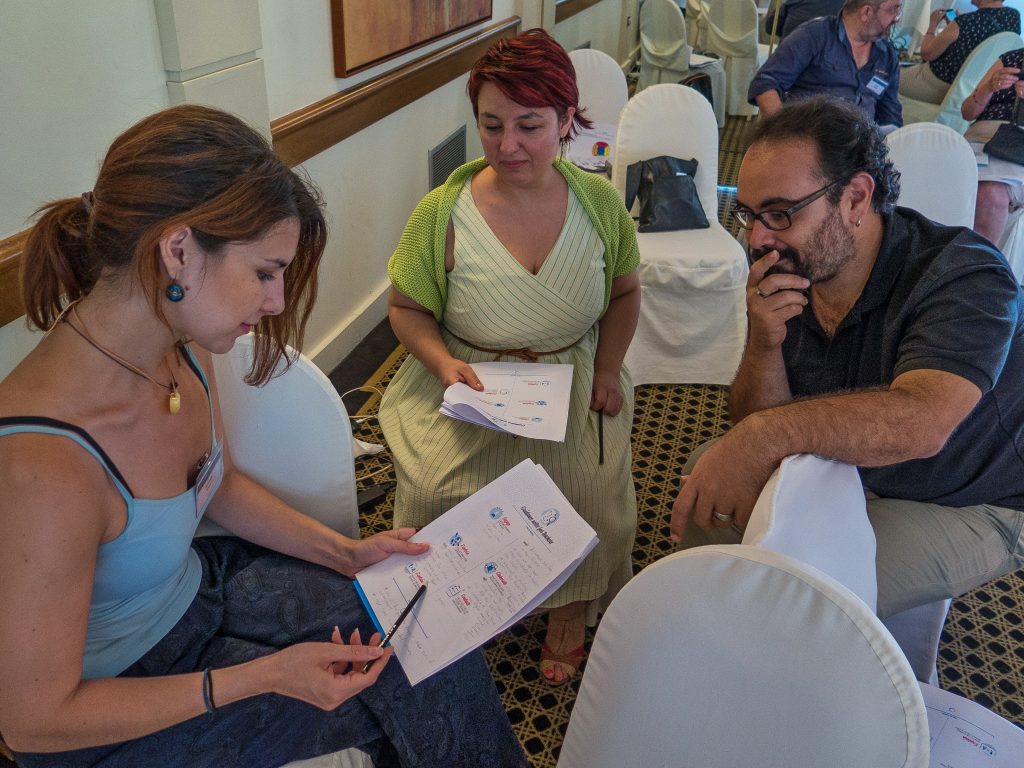Evaluation tool 13 – Peer interviews
What is this tool?
Peer interviews involve participants interviewing one another, and thereby hopefully allowing a more natural and honest conversation.
What kind of activities can I evaluate with it?
Peer interviews are particularly effective with secondary students and for interactive workshops or ongoing series of events (astronomy clubs, or courses), but can also be used with primary school students or interested adults and for online content and lectures / presentations.
Peer interviews at a glance…
| Who: |  |  |  | |||
| What: |  |  |  |  | ||
| Data: |  |  |  |  | ||
| Time: |  |  |  | |||
| Gain: |  |  |  |  | ||
| GLOs: |  |  |  |  |  |
When should I use it?
This tool is best suited to use at the end of (or after) an event.
What do I need?
- Pre-prepared prompt questions or topic guide
- Mechanism to collect responses (audio recorder(s), paper, follow-up discussion or similar)
- Time and space to hold the interviews

Let’s get started…
Effective briefing is essential for this technique. It may be helpful to create written instructions for participants to follow, or if time allows, have a short practice attempt and debrief prior to the “real” peer interviews. The idea is that the participants take turns in the roles of “interviewer” and “interviewee”, working with other participants to reflect on the event or activity.
Start by agreeing on the questions to be asked. You may wish to prepare this yourself in advance (and distribute a fixed list of prompt questions to your interviewers), or alternatively you can identify broad categories of interest, and ask the interviewers to come up with their own questions. The latter approach is more time consuming, but does have the advantage of authenticity, and having the questions phrased in their own natural language.
It’s also important to think in advance about how the data will be collected and subsequently analysed.
For example, you could use audio recorders (modern smartphones do the job very well), though this involves challenges in transferring the data to a central location, and the time required to listen to all the interviews in detail. Alternatively, you can ask your interviewers to write a short summary of the responses to each of the questions they ask, or simply hold a general discussion with all of the interviewers afterwards, asking them to reflect as a group on the responses to each area of interest.
Once you know how you will collect and analyse your data, brief your interviewers, and then provide them with space and time to go through those questions with other participants. Depending on the group involved this works well as either a paired or small group exercise, i.e. one interviewer speaking to another peer, or to a small group of their peers to gather their impressions.
Don’t be afraid of involving your participants (especially teenagers) in many of the above decisions.
Being part of the process, and having an input into how it is run, can be very empowering, and often means that they take it more seriously.
OK, what do I do with my data now?
Peer interview data is similar to any other form of qualitative data, and can be analysed in either a light- touch or an in-depth manner depending on what you want to achieve, and what you intend to do with the information collected. For example, a group discussion after the peer interviews are conducted might allow you to identify particular strengths and weaknesses of the event that you can then incorporate into future planning.
Alternatively, if you ask your interviewers to either audio record or write their responses, then you can analyse the written text (including transcripts of audio data) using the thematic coding approach, and use direct quotes to highlight key themes within your reports. This more in-depth analysis can then be included in reports or even future funding applications to reflect key outcomes of your programme, and convince others to support it further in future. The authentic “participant voice” that results from peer interview techniques can be very powerful in convincing wider stakeholders of the importance and/or effectiveness of a programme.
Similar techniques
Vox Pop – Create a set of evaluation questions for the young people to ask each other. Using simple video equipment such as a mobile phone, ask the young people to record the interviews. If the young people are uncomfortable with being filmed then you can film away from their face and film hands or feet while they’re talking instead. It’s very important to make sure the audio is recorded well. Also highlight that the film will only be used for evaluation and no other purpose.
Psychoanalysis – Participants get into pairs and interview one another about the event or activity. Importantly, the focus is on analysis of their experience and attitude towards it rather than factual recall of its content. For example, typical prompt questions could include:
- Can you describe to me the event/activity that you experienced today?
- What were your attitudes/beliefs before this event?
- How did your attitudes/beliefs change after participating in this event?
- How will/have your actions/decisions altered based on your participation in this event? How have your perceptions of others/events changed?
With thanks to the Woodcraft Folk for the ‘Vox Pop’ tool and University of Central Florida for the ‘Psychoanalysis’ tool.
Download worksheet
Download the Peer interviews tool worksheet
Back to Tools

